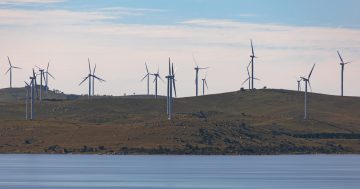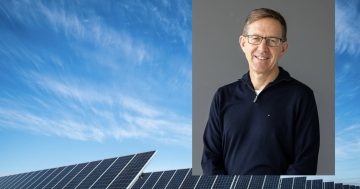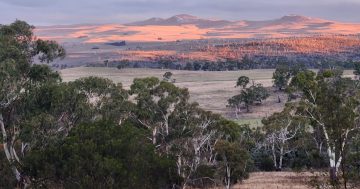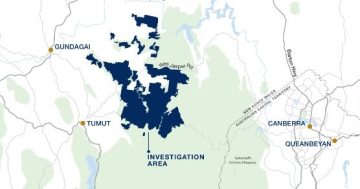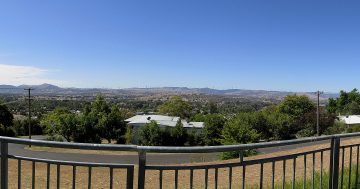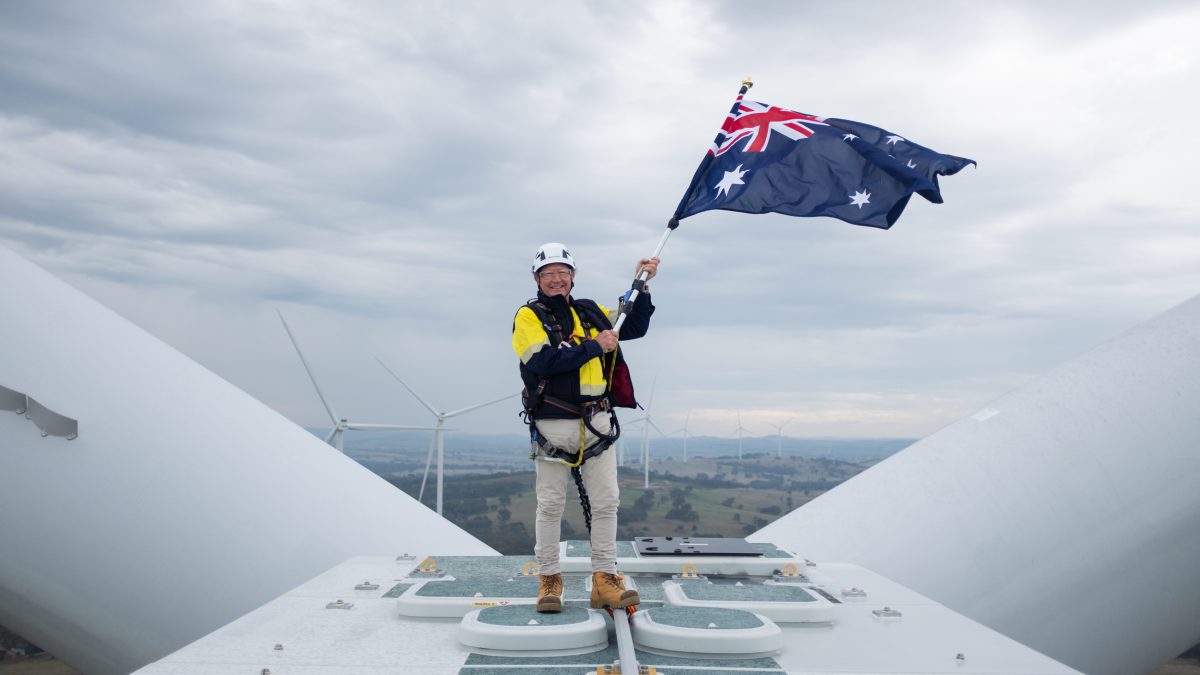
Dr Andrew Forrest atop one of the 200-metre turbines near Boorowa last week. Photo: Squadron Energy.
As Andrew Forrest ascended a colossal wind turbine to wave the Australian flag near Boorowa, a trio of farmers stood quietly by.
They’d witnessed the official opening ceremonies for the Bango Wind Farm, bemused by the scatter of media scurrying around under grey skies and a nifty breeze.
For John and Jeremy McGrath, and Wal Archer, the scene was remarkable. Not so much the flag being hoisted atop the turbine – one of 46 scattered along the Kangiara ridgeline between Boorowa and Yass – but the fact that for the first time in their lives, they arrived at that point on the map by bus.
“I think that’s been the most surreal part of the day so far,” said Jeremy. “We’re usually up here on four-wheel bikes.”

The giant turbines on John and Jeremy McGrath’s Boorowa farm. Photo: Edwina Mason.
The McGraths are immensely proud that 15 years of discussion, planning and some mild disruption had led to the point where their 185-year-old farming enterprise – always home to sheep and crops – now houses one of the largest wind farms in NSW.
And it’s not just the McGraths. Along with Mr Archer, there are nine host landowners for Bango Wind Farm whose lives won’t change that much even though their skyline has.
There is, of course, the financial stability and an incredible 38 kilometres of internal roads, ramps and gates – a farmer’s dream – with enough rock left over to buttress erosion-prone creek beds.
Knowing their land can be harvested for good, preventing 543,000 tonnes of carbon emissions from being released into the atmosphere, also ticks a giant box in a world where climate change is rapidly creeping into their livelihood.
Each turbine reaches 200 metres from base to tip, and each blade is 77.4 metres long – and the wind farm’s combined output generates enough electricity to power 144,000 homes.
During construction, the project supported more than 320 jobs, which included 190 locals, and injected $190 million into the regional economy, with $3.9 million contributing to community projects and initiatives in the Yass and Hilltops shires over its life.
Bango Wind Farm’s turbines are now fully operational and generating clean, renewable energy for Squadron Energy – Australia’s largest renewable energy company and an offshoot of Andrew and Nicola Forrest’s Tattarang Group.
Dr Forrest said Friday’s opening of Bango Wind Farm was not only an important milestone for Squadron Energy. As he cut through the ceremonial ribbon to officially open the $500 million wind farm, he said it was “another cut in the throat of the fossil fuel industry”.
“As an industry, we need to deliver an average of 40 wind turbines a month to reach the Federal Government’s target of 82 per cent renewables by 2030,” he said.
“Today, we’re delivering 46 turbines in the first wind farm to come online in NSW in more than a year.
“We cannot underestimate the challenge in front of us and the urgency at which we all need to act to meet this target. Climate change is no longer a prediction; we are living right now in the era of fossil fuel-driven, global warming acceleration.
“As a group of companies, and particularly as Squadron, we must do all we can to help our nation eliminate pollution.
“Business, in full partnership with government, must work to do everything we can to bring our emissions down as a nation. Squadron will play a leading role in this, providing one-third of the energy required to reach 82 per cent renewables by 2030.”

Kangiara farmers Wal Archer and John McGrath at the Bango Wind Farm launch. Photo: Edwina Mason.
Squadron Energy CEO Jason Willoughby said he was thrilled to mark the opening of Bango, which follows Crudine Ridge Wind Farm near Mudgee entering operations in early 2022.
“This is another step forward for our company as we deliver on our 20 GW development pipeline of wind, solar and battery projects across Australia,” Mr Willoughby said.
“I’d like to extend my gratitude to all those who have contributed to this success, including our dedicated team and our valued partners, including our landowner hosts”.
Along with the operational Sapphire Wind Farm near Glen Innes, the opening of Bango Wind Farm means Squadron Energy is now supplying 80 per cent of the combined electricity needs of Sydney’s Eastern Distributor, Cross City Tunnel, Hills M2, Lane Cove Tunnel and WestConnex toll roads.
It also plays a crucial role in making groceries greener after Woolworths agreed to purchase electricity from Bango for about 30 per cent of its NSW energy needs, the equivalent of 108 supermarkets.
Snowy Hydro and Transurban have also signed power purchase agreements to buy electricity from Bango.








